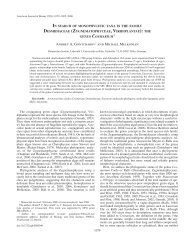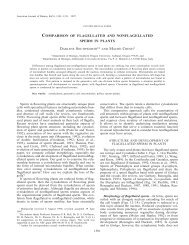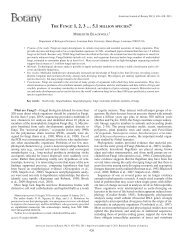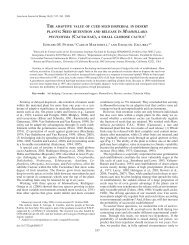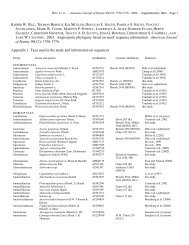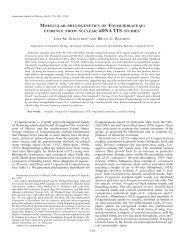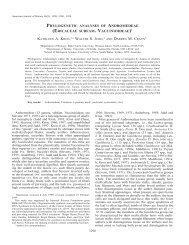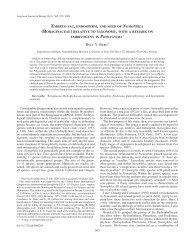Gregory Carrier 2,6 , Sylvain Santoni 3 , Marguerite Rodier-Goud 4 ...
Gregory Carrier 2,6 , Sylvain Santoni 3 , Marguerite Rodier-Goud 4 ...
Gregory Carrier 2,6 , Sylvain Santoni 3 , Marguerite Rodier-Goud 4 ...
You also want an ePaper? Increase the reach of your titles
YUMPU automatically turns print PDFs into web optimized ePapers that Google loves.
All protocols for Next Generation Sequencers (NGS) start<br />
with the preparation of a DNA library from extracted DNA.<br />
Quality, number, and length of the sequences produced by NGS<br />
all depend on the quality of the library that was prepared, itself<br />
dependent on the DNA quality. Generally, when using NGS,<br />
one would wish to obtain the genomic information contained in<br />
the nucleus without an excessive proportion of cytoplasmic<br />
DNA. Multiple copies of cytoplasmic genomes are present in<br />
every cell (11 to 70 copies, depending on the developmental stage<br />
and/or physiological status) ( Tymms et al., 1983 ). The chloroplast<br />
DNA of plants, therefore, represents 17 – 23% of their total<br />
DNA ( Boffey and Leech, 1982 ).<br />
In this study, we developed a protocol that strongly reduces<br />
the amount of cytoplasmic DNA. The improvement in quality<br />
1 Manuscript received 22 September 2010; revision accepted 24 October 2010.<br />
This work was funded by the French Ministry of Research and Higher<br />
education and the French Ministry of Food, Agriculture and Fisheries,<br />
including a grant from the IFV for GC. We are grateful to Genotoul of<br />
INRA Toulouse and Illinois University core facility for their help and advice<br />
on NGS, and to Romain Guyot and Sylvie Faure for manuscript corrections.<br />
We acknowledge Helen McCombie-Boudry for improving the English.<br />
Authors ’ contributions: GC designed the protocol, carried out the nuclei<br />
extraction, performed the grape 454 experiments and drafted the manuscript.<br />
SS designed the experiment and helped to draft the manuscript. MRG<br />
performed the microscope experiments. AC participated in the design of<br />
the protocol. AdK and CDT provided the coffee material and analyzed<br />
coffee 454 runs. JMB, PT, and LLC conceived and coordinated the study<br />
and helped to draft the manuscript. All authors read, corrected, and approved<br />
the fi nal manuscript.<br />
6 Author for correspondence: gregory.carrier@supagro.inra.fr<br />
doi:10.3732/ajb.1000371<br />
AJB Advance Article published on December 23, 2010, as 10.3732/ajb.1000371.<br />
The latest version is at http://www.amjbot.org/cgi/doi/10.3732/ajb.1000371<br />
AJB Primer Notes & Protocols in the Plant Sciences<br />
A N EFFICIENT AND RAPID PROTOCOL FOR PLANT NUCLEAR<br />
DNA PREPARATION SUITABLE FOR NEXT GENERATION<br />
SEQUENCING METHODS 1<br />
American Journal of Botany: e1–e3, 2011; http://www.amjbot.org/ © 2011 Botanical Society of America<br />
e1<br />
American Journal of Botany: e000–e000. 2011.<br />
<strong>Gregory</strong> <strong>Carrier</strong> 2,6 , <strong>Sylvain</strong> <strong>Santoni</strong> 3 , <strong>Marguerite</strong> <strong>Rodier</strong>-<strong>Goud</strong> 4 ,<br />
Aur é lie Canaguier 5 , Alexandre de Kochko 3 , Christine Dubreuil-Tranchant<br />
Patrice This 3 , Jean-Michel Boursiquot 3 , and Lo ï c Le Cunff 2<br />
2 UMT Geno-Vigne, IFV-INRA-Montpellier Supagro, 2 place Viala, F-34060 Montpellier, France; 3 UMR 1097 DIAPC,<br />
INRA-IRD-Montpellier Supagro, 2, place Viala, F-34060, Montpellier, France; 4 UMR 1098 DAP, CIRAD-INRA-Universit é<br />
Montpellier II, Avenue Agropolis 34398 Montpellier France; and 5 UMR 1165 INRA-CNRS-Universit é d ’ Evry G é nomique<br />
V é g é tale, 2 rue Gaston Cr é mieux 91057 Evry, France<br />
Premise of the study : In this study, we developed a nuclear DNA extraction protocol for Next Generation Sequencers (NGS).<br />
Methods and Results : We applied this extraction method to grapevines and coffee trees, which are known to contain many<br />
secondary metabolites. The nuclear DNA obtained was sequenced by the 454/GS-FLX method. We obtained excellent results,<br />
with less than 4% cytoplasmic DNA, in a similar way to a BAC (Bacterial Artifi cial Chromosome) – building protocol. We also<br />
compared our protocol with a classic DNA extraction using specifi c cytoplasmic DNA amplifi cation. Results showed a lower<br />
cytoplasmic DNA contamination with the new protocol.<br />
Conclusions : The method presented here is fast and economical. The DNA obtained is of high quality, with a low level of<br />
cytoplasmic DNA contamination, and very effi cient for the construction of sequencing libraries.<br />
Key words: next generation sequencers; nuclear plant DNA extraction; nuclei isolation.<br />
Copyright 2010 by the Botanical Society of America<br />
makes the method perfectly adapted to library construction for<br />
NGS. We applied this extraction method to the grapevine ( Vitis<br />
vinifera L.) and coffee tree ( Coffea canephora Pierre ex A.<br />
Froehner). These species are known to contain many secondary<br />
metabolites, which can generate diffi culties for DNA extraction<br />
( Peterson et al., 1997 ; Mattivi et al., 2006 ).<br />
To establish the protocol, we were partially inspired by a<br />
classic protocol for nuclear DNA plant extraction destined for<br />
the construction of BAC (Bacterial Artifi cial Chromosome) libraries<br />
( Peterson et al., 1997 ). The two stages of the protocol<br />
are: (i) isolation of nuclei and (ii) nuclear DNA extraction. Nuclear<br />
DNA obtained with this protocol was then sequenced using<br />
454/GS-FLX technology (Roche, Basel, Switzerland) with<br />
the Titanium kit.<br />
MATERIALS AND METHODS<br />
All details of different steps of protocol are accessible in the supplementary<br />
methods (see Appendix S1).<br />
For the fi rst step, we used the “ option Y ” described by Peterson et al. (2000)<br />
with a small modifi cation for nuclei isolation. The quantity of DNA necessary<br />
to build a sequencing library has to be between 2 and 5 µ g, and of a quality<br />
equivalent to that necessary for BAC library construction. To obtain this DNA,<br />
we started with 5 to 6 g of leaves. Nuclei extraction is performed by fi rst crushing<br />
the leaves quickly with a mortar and pestle in liquid nitrogen, so that enough<br />
intact nuclei are freed. A fi ne homogeneous powder is then obtained, which is<br />
suspended in a sucrose-based buffer containing 2- β -Mercaptoethanol and PVP<br />
to protect nuclei from oxidation. The pH is maintained relatively high to inhibit<br />
nuclease activity. The addition of Triton X-100 degrades some of the chloroplasts<br />
and mitochondria. This stage requires care, however, as it cannot be extended:<br />
lengthening the incubation would also lead to destruction of the nuclei.<br />
We used additional fi ltration steps compared with the protocol of Peterson<br />
et al. (2000) . After fi ltration through Miracloth and all the centrifugations, a<br />
3 ,
e2 American Journal of Botany [Vol. 0<br />
Fig. 1. Picture of nuclei grapevine extract with in DAPI coloration. Two pictures taken using a fl uorescence microscope. Blue corresponds to DNA,<br />
red to chlorophyll, and green to fragment wall. Intact nuclei (blue spheres) and a few chloroplasts (red spheres) are visible on this grapevine extraction.<br />
fi ltration step is done with a cell strainer (d: 40 µ m). The different stages of slow<br />
centrifugation allow the nuclei to be precipitated in the bottom of the tube,<br />
whereas fragments, chloroplasts, and mitochondria remain at the surface and<br />
are then eliminated by fi ltration. After nuclei isolation, we examined a drop of<br />
the suspension under a fl uorescence microscope with DAPI. Figure 1 shows the<br />
large numbers of intact nuclei present in this suspension. We compared the<br />
quality of visible chloroplasts in DAPI before and after nuclei purifi cation and<br />
noted a signifi cant reduction in chloroplast number.<br />
The second step of the protocol was nuclear DNA extraction. The objective<br />
of preparation for a BAC library is to remove high molecular weight nuclear<br />
DNA. Nuclear DNA for NGS does not require this to be done because the DNA<br />
used for NGS is fragmented during library preparation. DNA extraction of a<br />
nuclei suspension can be made with a commercial kit such as DNeasy Plan<br />
Maxi Kit from Qiagen (Hilden, Germany). In this study, we preferred to use a<br />
protocol in which we had complete control of all the steps, to obtain DNA of<br />
high quality. In this procedure, the nuclei suspension obtained is then treated by<br />
proteinase K in the presence of lauryl sarkosyl detergent, which helps membrane<br />
lysis and the denaturation of cytoskeletal proteins, thus permitting the<br />
freeing of nuclear DNA. To purify the DNA, a precipitation with potassium<br />
acetate (salting out) eliminates broken cells and a maximum of distorted proteins.<br />
Specifi c absorption of DNA is realized on silica matrix ( Boom et al.,<br />
1990 ). The fi nal impurities are then eliminated by a succession of several<br />
washes. Purifi ed DNA is then cleared of any alien element and is in an optimal<br />
condition for use and conservation.<br />
The quantity of purifi ed nuclear DNA was measured by the PicoGreen<br />
method ( Murakami and McCaman, 1999 ). For grapevine and coffee tree, 12 and<br />
7 µ g of nuclear DNA were extracted, respectively, from 5 g of leaves of each<br />
species. Protocols for DNA library construction for the 454/Titanium (Roche)<br />
sequencing technology recommend using 2 to 5 µ g of DNA. The improved<br />
protocol we present here is therefore perfectly adapted to these quantities.<br />
We used 454/GS-FLX Titanium as the NGS methodology to test our protocol,<br />
but it is suitable for any other sequencing method. The 454 runs were successful.<br />
For grapevine two runs were made, and we obtained 988 669 and<br />
1 052 396, sequences, with mean lengths of 350 and 360 bp, respectively. For<br />
coffee tree, a total of six runs were made. On average 1 325 441 sequences per<br />
run were obtained for a mean length of 383 bp. These excellent results, although<br />
they also depend on the quality of the sequencing libraries, are mainly<br />
due to a high standard of the purifi ed DNA.<br />
Cytoplasmic reference sequences are not available for coffee tree. Therefore,<br />
to quantify the level of contaminant cytoplasmic DNA sequenced, we<br />
worked on the grapevine dataset only. A BLAST search was conducted on<br />
grapevine reference sequences from the NCBI website (http://www.ncbi.nlm.<br />
nih.gov, Vitis vinifera chloroplast: NC 007957; Vitis vinifera mitochondrion:<br />
NC 007762). Out of all sequences produced in the tests of our protocol, we<br />
found that, on average, 1.7% were chloroplastic-like and 2.0% were mitochondrial-like<br />
(E-value < 1e-50 and percentage identities > 85%). These results<br />
show an elimination of a large proportion of cytoplasmic DNA by our protocol.<br />
To compare this protocol with standard DNA extraction (Qiagen DNeasy<br />
plant ), we used primer sets that specifi cally amplifi ed the ATPi and RPS16 chloroplastic<br />
genes ( Heinze, 2007 ) on four different concentrations of DNA (1 ng/ µ l,<br />
0.1 ng/ µ l, 0.01 ng/ µ l and 0.001 ng/ µ l). Results clearly indicated no amplifi cation<br />
from 0.1 ng/ µ l with our protocol, while amplifi cation was achieved at this<br />
concentration using the classic DNA extraction method. There is no amplifi cation<br />
from 0.01 ng/ µ l using the classic DNA extraction method ( Fig. 2 ) . This<br />
level of cytoplasmic DNA is similar to those obtained using BAC-building protocols<br />
( Noir et al., 2004 ; Zharkikh et al., 2008 ). Cytoplasmic DNA is still suffi<br />
ciently present to be sequenced during an NGS sequencing run. This aspect<br />
could be valuable for gaining access to genomic information about cytoplasmic<br />
DNA in an NGS run, without having an excessive proportion of these<br />
sequences.<br />
Fig. 2. Estimation of the elimination of chloroplastic DNA using the<br />
new method compared with a classic DNA extraction protocol. (A) Specifi c<br />
amplifi cation of ATPi. (B) Specifi c amplifi cation of RPS16, from different<br />
DNA concentrations: 1ng/ µ l, 0.1 ng/ µ l, 0.01 ng/ µ l, 0.001 ng/ µ l with DNA<br />
classic extraction.
January 2010] AJB Primer Notes & Protocols – Plant nuclear DNA preparation for next sequencing methods<br />
CONCLUSIONS<br />
The protocol presented here is fast, economical (compared<br />
with a purchased kit), and does not require the use of dangerous<br />
products. It provides adequate quantities of high-quality nuclear<br />
DNA, low in cytoplasmic contaminants, and effi cient for constructing<br />
sequencing libraries. This protocol can be adapted for<br />
DNA preparations from many other plants containing high levels<br />
of phenolic compounds or polysaccharides, and it is suitable<br />
for all deep-sequencing technologies.<br />
LITERATURE CITED<br />
Boffey , S. A. , and R. M. Leech . 1982 . Chloroplast DNA levels and<br />
the control of chloroplast division in light-grown wheat leaves. Plant<br />
Physiology 69 : 1387 – 1391 .<br />
Boom , R. , C. J. Sol , M. Salimans , C. Jansen , P. Werthem van Dillen ,<br />
and J. van des Noordaa . 1990 . Rapid and simple method for<br />
purifi cation of nucleic acids. Journal of Clinical Microbiology 2 8 :<br />
495 – 503 .<br />
Heinze , B. 2007 . A database of PCR primers for the chloroplast genomes<br />
of higher plants. Plant Methods 3 : 4 .<br />
e3<br />
Mattivi , F. , R. Guzzon , U. Vrhovsek , M. Stefanini , and R. Velasco .<br />
2006 . Metabolite profi ling of grape: Flavonols and anthocyanins.<br />
Journal of Agricultural and Food Chemistry 54 : 7692 – 7702 .<br />
Murakami , P. , and M. T. McCaman . 1999 . Quantitation of adenovirus<br />
DNA and virus particles with the PicoGreen fl uorescent dye.<br />
Analytical Biochemistry 274 : 283 – 288 .<br />
Noir , S. , S. Partheyron , M. C. Combes , P. Lashermes , and B.<br />
Chalhoub . 2004 . Construction and characterisation of a BAC library<br />
for genome analysis of the allotetraploid coffee species ( Coffea<br />
arabica L.). Theoretical and Applied Genetics 109 : 225 – 230 .<br />
Peterson , D. , K. Boehm , and S. Stack . 1997 . Isolation of milligram<br />
quantities of nuclear DNA from tomato ( Lycopersicon esculentum ),<br />
a plant containing high levels of polyphenolic compounds. Plant<br />
Molecular Biology Reporter 15 : 148 – 153 .<br />
Peterson , D. G. , J. P. Tomkins , D. A. Frisch , R. A. Wing , and A. H.<br />
Parterson . 2000 . Construction of plant bacterial artifi cial chromosome<br />
(BAC) libraries. Journal of Agricultural Genomics 5 : 1 – 100 .<br />
Tymms , M. J. , S. Scott , and J. V. Possingham . 1983 . DNA content of<br />
beta vulgaris chloroplast during leaf cell expansion. Plant Physiology<br />
71 : 785 – 788 .<br />
Zharkikh , A. , M. Troggio , D. Pruss , A. Cestaro , G. Eldrdge , M.<br />
Pindo , J. T. Mitchell , et al . 2008 . Sequencing and assembly<br />
of highly heterozygous genome of Vitis vinifera L. cv Pinot Noir:<br />
Problems and solutions. Journal of Biotechnology 136 : 38 – 43 .



